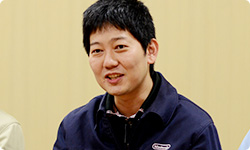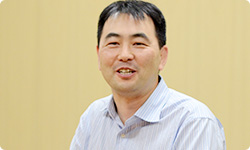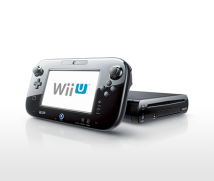3. ''It Comes Down to Guts!''
When it comes to wireless, you’re dealing with invisible radio waves, so I would guess you ran into a lot of problems you were previously unaware of. Mae-san, what happened along the way to stabilising the wireless?
The biggest problem with regard to wireless was the sending after compression for CG (computer graphics). CG is completely different from natural images, and in order to display the images at a decent quality after compression and decompression, we needed quite a lot more bit rate18 than we had originally had thought. 18 This expresses the amount of data that can be sent and received per second. Generally, a higher bit rate means higher image and sound quality, but the data size increases. On the other hand, if the bit rate is smaller, data size decreases, but image and sound quality also decrease.

Basically, the technology for compressing and decompressing images is thought about from the point of view of how you compress natural images. Specifically on how the human eye captures images of the world. For example, the human eye is sensitive to certain things but not so much to other things. So if you do such-and-such, the image quality won’t appear degraded. This was possible with natural images, but with CG, that technology doesn’t apply.
Right. The early sample CG that we sent wirelessly was rather primitive, a crisp image without gradation. But it was a detailed and considerably difficult image to compress.
The size changed in scale, so it moved in a convoluted and difficult way to track.
Generally in video compression technology, the previous image is compared with the current image to determine how the object has moved, to perform compression. But when the object’s movement cannot be determined, the compression doesn’t work well.
I think it was the second sample. At first, it was just an image of a cube moving around, and we thought that was all right, but with the next sample, a grid-shaped pattern would enlarge and rush at you.
A moving grid! The worst possible image in terms of video compression technology!
To be honest, that had me worried! (laughs)
In the world of video compression technology, there are such things as types of video that are more ideal to compress, and those that aren’t well suited. You faced one of the most difficult things in a sample right around the start and thought, “Oh no! This is a disaster!”
Yes. That was about a little before E319 last year (2011). We held an emergency meeting including Ito-san and Mae-san and said, “What are we going do about this?!” But in the end, I think it was good that we found such a difficult video when we did . 19 A videogame trade show usually held in Los Angeles.
Then you worked on tuning it for about a year.
Yes. We focused on it constantly. But not much else that was that difficult appeared, so we’re using that for the test sample even now.
No video has surpassed that... yet. So it was good that we found that at an early stage. A big thing for me personally was, just before E3 last year, we scrambled to improve the image quality so we could display Wii U at the show.
It was hard work, but showing it at E3 was a good thing.
Yeah. Mae-san was in America then, and twice a day, once late at night and once early in the morning, we were holding lots of phone meetings to figure out how we could raise the bit rate and improve the image quality.
Yeah. I still can’t forget those three weeks! (laughs)
I can’t forget them either! (laughs) When we ran software on the Wii U GamePad, some problems arose that were different than the case with the sample CG. When we displayed images meant for the TV on the LCD screen on the Wii U GamePad, noise specific to compression technology was appearing during fade-in and fade-out. So at E3, Ito-san and I were running around the development teams that were working on exhibit titles.
We went around them all in order to confirm the noise with our own eyes.
Some games had less noise than I expected, while for others there were some instances that caught us off guard like, “Really? It’s having a hard time with this scene?!”
What humans expect often turns out differently with the CG image. Sometimes noise becomes unapparent just by changing the speed of the fade-in or fade-out. Making those adjustments was challenging.
For example, something with a lot of small characters appearing like Pikmin20 was surprisingly all right. 20 The first game in the Pikmin series, released for the Nintendo GameCube system in October 2001 in Japan. Pikmin 3 is scheduled to launch for Wii U in 2013.
On the contrary, a big surprise was how so much noise appeared in Super Mario when coins came rushing out.
Yes. That defied my expectations somewhat . It was like, “Oh, it has difficulty in situations like this...” It was a little different from the assumptions we made with the compression algorithm.

It really is difficult to race down a path no one has been down before. With regard to the wireless communication technology, you joined with your development partners in a different way than usual, didn’t you?
Yes. We co-developed with Broadcom21, one of the world’s leading wireless chip vendors. NTD’s David Tran also co-operated. When working on development together in distant lands, Japan and USA, you have to exchange information in a timely way and share certain tasks, so we held frequent phone meetings to resolve each agenda. 21 A company that manufactures and sells semiconductor products geared toward wireless and broadband communication. Headquarters: California.
Even though it must not have been any typical wireless technology, I think Broadcom helped in a wide variety of ways. How were you able to overcome the challenges?
Well, there were things we were able to do by utilising the latest technologies and capabilities that were unique to Broadcom. And ultimately, it was a company Takeda-san chose. They were able to work hard with until we reached the final objective.
Yes, Takeda-san’s selection of partners is incredibly interesting. He says, “We need people with guts!” The tasks on hand are very scientific, and guts seem to be the furthest thing from! (laughs)
(laughs)
But he says, “In the end, it comes down to guts!” And most of the time it really does.
Yes, that’s very important. In situations like rushing to make improvements for E3 last year, people with the willpower and perseverance to see it through really exert tremendous strength at those heated moments.
When people like that get serious, what was up until then thought to be impossible suddenly comes together.
Yeah. I think we were able to achieve this wireless system by drawing on their power!
